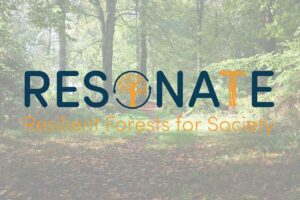Chartered Forester Stuart Wilkie FICFor CEnv, Environment and Certification Manager at Scottish Woodlands, talks about forestry without plastic.
Oceans of floating plastic, images of choking turtles, a ban on all ‘unnecessary plastic’ by 2042. The world is waking up to the environmental damage caused by oil-based plastics. I believe that while government may be moving on a 25-year timeframe, public opinion will make plastic use much harder to justify, in a much shorter timescale. Witness the rush by supermarkets and coffee shops to reduce plastic use.
Can we be in the forefront, championing wood and paper as replacements for plastic while relying on the co-extruded plant bag and tree shelter? Can forestry keep its environmental credentials unless we also act?
If the purpose of these blogs is to initiate debate, let’s take a critical look at forestry’s favourite plastic products especially the stuff we let fall apart in woodlands.
The Tree Shelter
I must admit that I cringe every time I reach the north end of the new Queensferry Crossing over the Forth. Thousands upon thousands of tree shelters have been used in the landscaping. Was there not a more sustainable alternative, a better way of doing things?
Do tree shelters really degrade to harmless products? I know of some that are over 20 years old and stopped believing degradability claims years ago. Clients are not always willing to pay for the removal of shelters, so many are left to break down into ever smaller pieces. Can we really accept that there is such a thing as a harmless flake of plastic in the environment any longer? With animals and birds found emaciated and dying having ingested a stomach full, can we as foresters really fill the food chain with plastic?
It is not about the products of chemical decomposition, but the damage the physical presence of pieces of plastic does in the environment.
 Encouraged by successive grant schemes, foresters have embraced tree shelters as a panacea for broadleaf establishment, but are they? Have we become lazy in their use? Derek Patch’s article in the last issue of Chartered Forester was an interesting reminder of an all too common problem.
Encouraged by successive grant schemes, foresters have embraced tree shelters as a panacea for broadleaf establishment, but are they? Have we become lazy in their use? Derek Patch’s article in the last issue of Chartered Forester was an interesting reminder of an all too common problem.
Surely, as professional foresters, we can come up with alternative and innovative solutions beyond the tree shelter and demand more sustainable products when we do use them. The right tree shelter, and only in the right place?
It is not just tree shelters of course. What about all those little bits of bailer twine around bundles of plants. Do your planters pick them all up and bag them?
Plant Bags
There was a time, it seems not so long ago to some of us, before the co-extruded plant bag. Trees were bee-hived or sheughed in (heeled in) prior to planting. We got by without trees in plastic bags and I think we were much more aware of plant handling. Bags are cheap, convenient, and unlike tree shelters, most bags are recovered from site. Perhaps bags are not the same environmental problem as shelters, (although many go to landfill). But we don’t need them. So, what does “unnecessary plastic” mean in terms of the government’s commitment. At what level would a plastic tax make us think again on their use?
Accept the age of plastic is over
Of course, things will not change overnight but we have a responsibility here. In the short term to reduce our plastic use and to recover plastic when we do use it. The challenge for the manufacturers of plastic products is to come up with a biodegradable (preferably wood fibre) alternative. As foresters we need to challenge the accepted way of doing things, lead innovation and put pressure on our suppliers.
Disclaimer: The views and opinions expressed in this article are those of the author and do not necessarily reflect the views of the Institute of Chartered Foresters.
Scottish Woodlands is one of the Headline Sponsors for the Institute’s 2018 National Conference: Innovation for Change.






